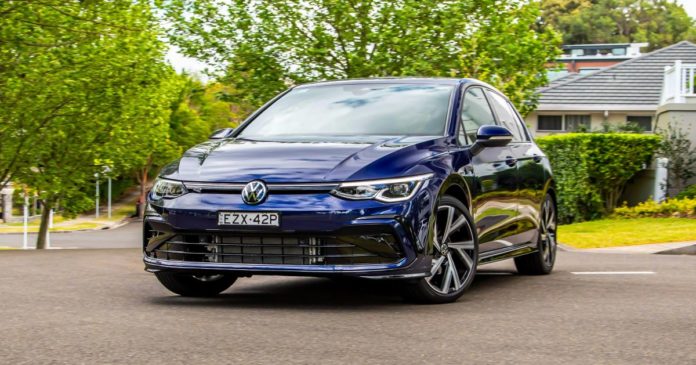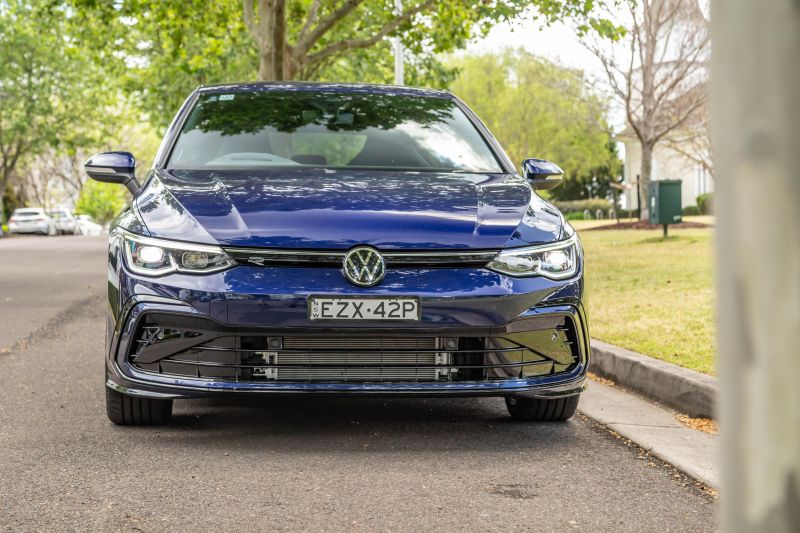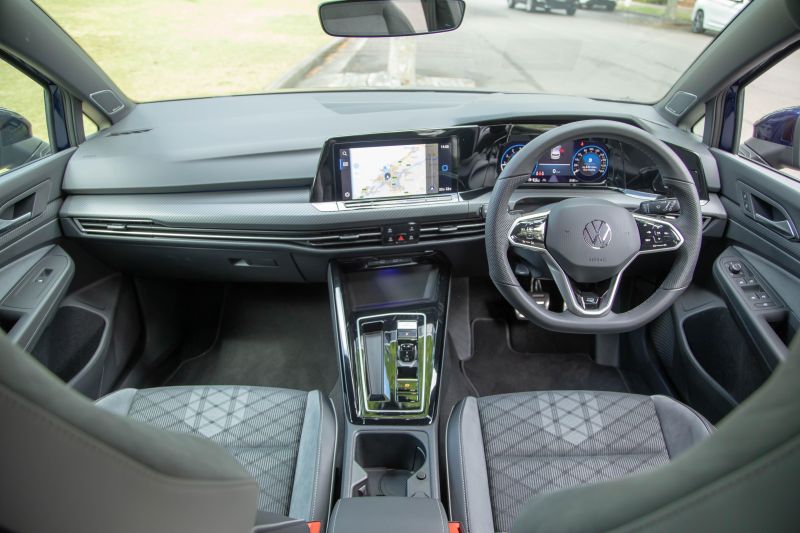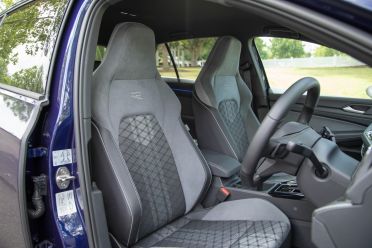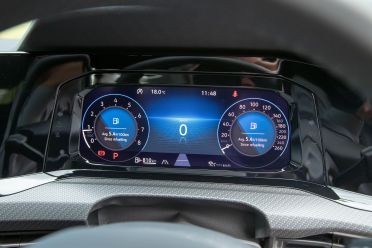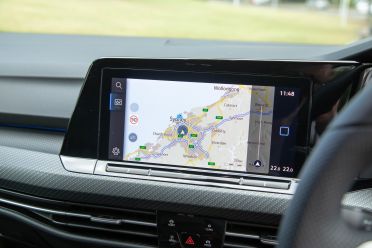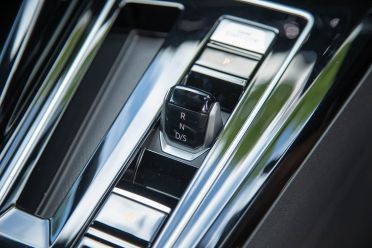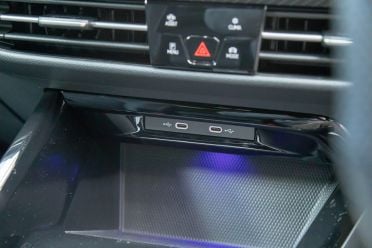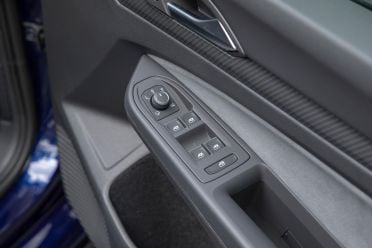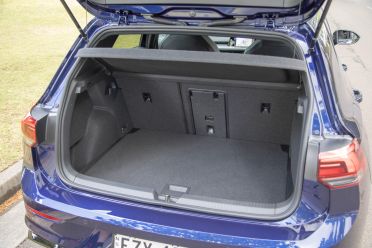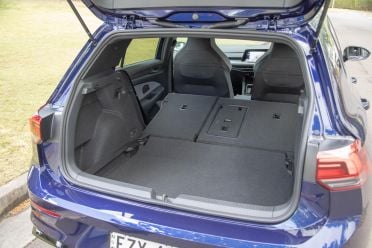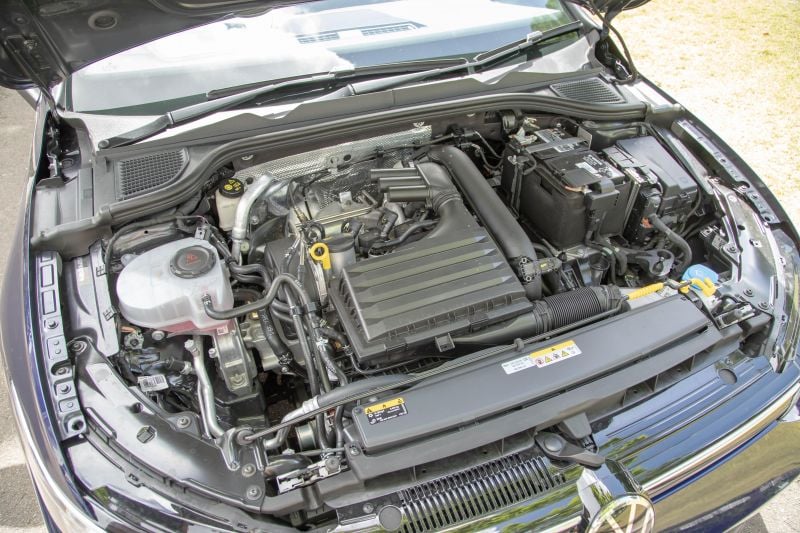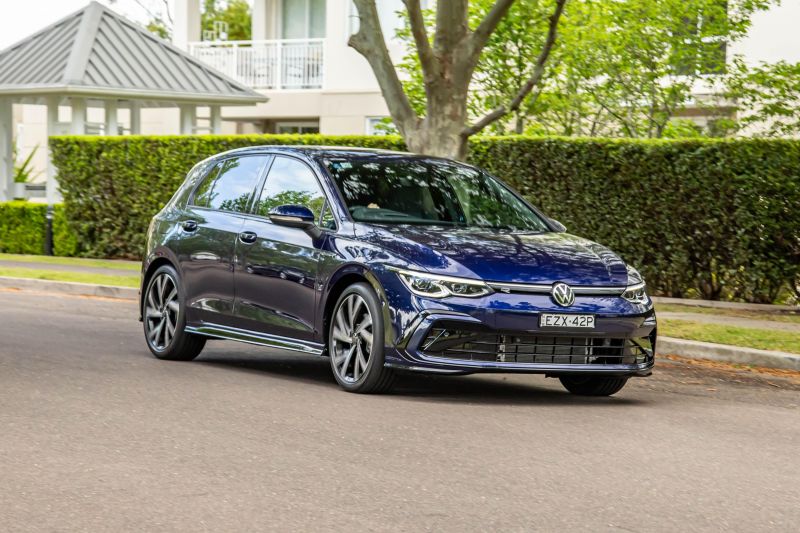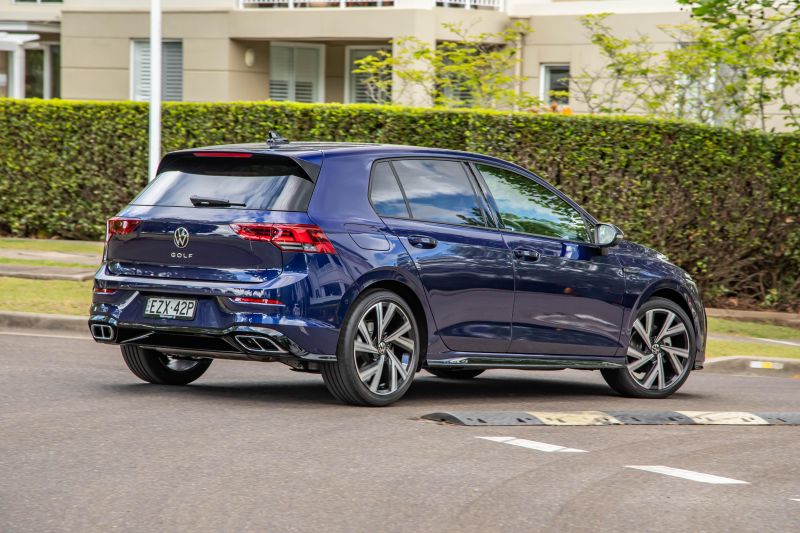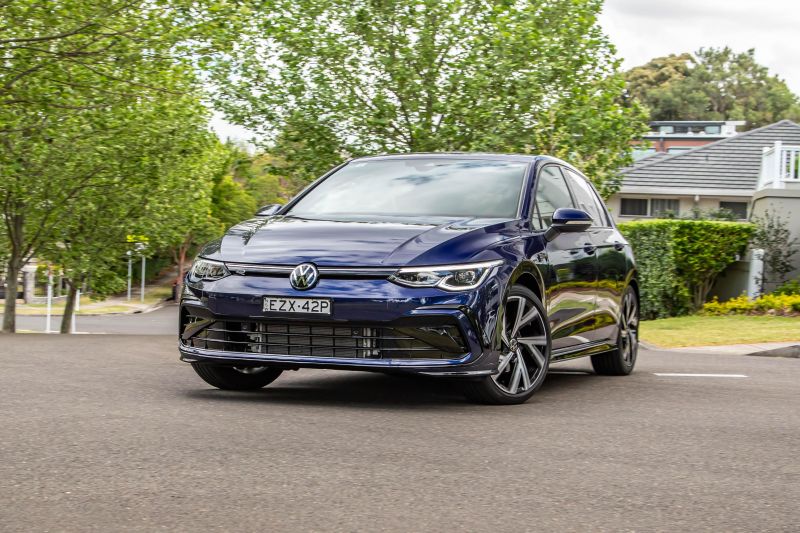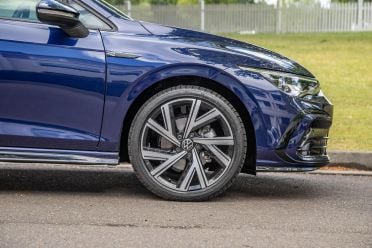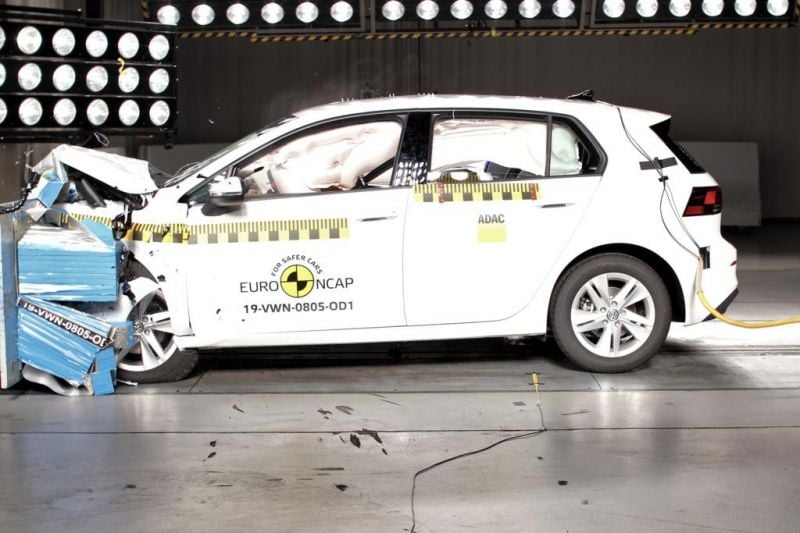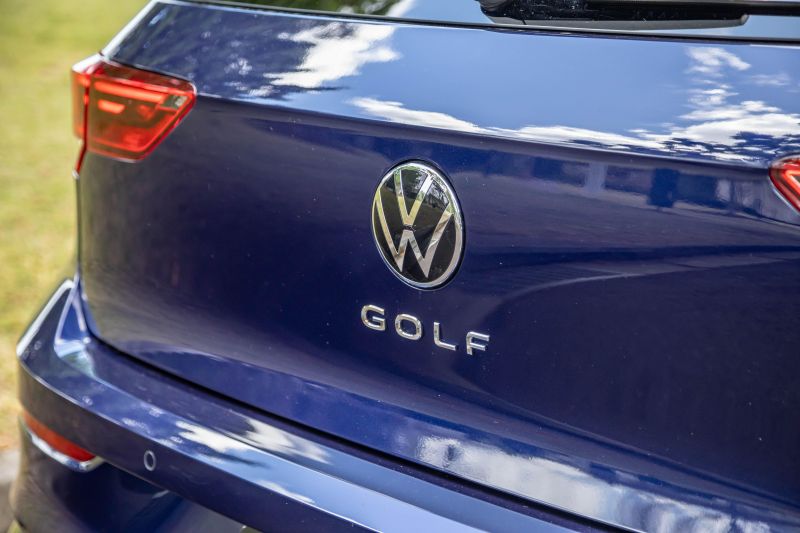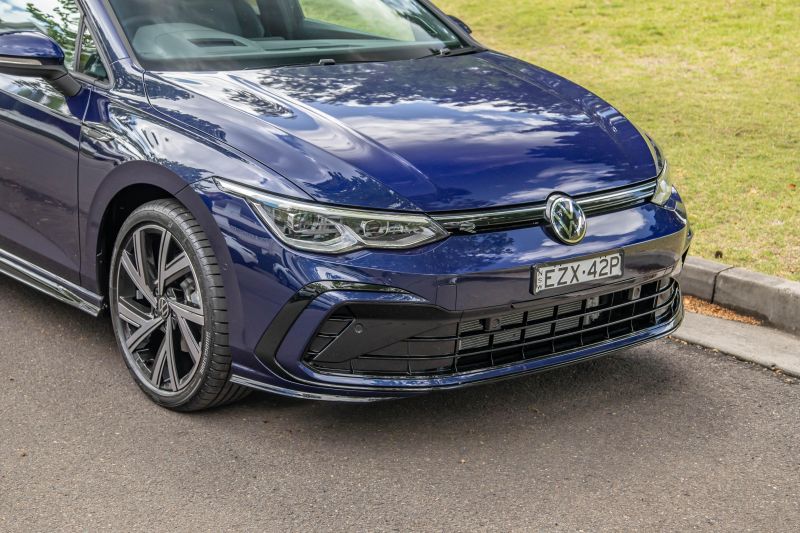Are you the sort of person who would be okay with a ‘Cucci’ handbag? Or some ‘Mike Air Jordams’?
Well… has Volkswagen got a deal for you! That’s because this is not a Golf R, but you could be convinced – at a glance, that it is.
The Volkswagen Golf R-Line is not a new concept – there have been R-Line takes on the small hatch theme before.
However, this one has a higher price than any previous version, and it doesn’t even have the snappy DSG dual-clutch transmission that sporty Golfs get.
So, is it fun enough to fool you into thinking it’s a smart buy? Read on to find out.
How much does the Volkswagen Golf cost?
The 2024 Volkswagen Golf R-Line starts from $41,690 plus on-road costs.
That means it’s a $3100 jump over the Golf Life ($38,590) but represents an almost-$14,000 discount over the GTI ($55,490).
We’ll run through the standard equipment in more detail below, but just know that compared to the Life the R-Line looks sportier, drives sportier and feels sportier inside. Maybe it’s even enough to convince you that the extra spend on a GTI won’t be necessary…
So, what about rivals? You’re looking squarely at the likes of the Hyundai i30 Hatch N Line Premium ($39,000), Peugeot 308 GT ($43,990), Mazda 3 G25 Astina Hatch ($42,320). And hey, a Cupra Leon V isn’t that far up to jump, at $45,190.
What is the Volkswagen Golf like on the inside?
It looks and feels a lot more upmarket than the basic Golf, and that’s part of the reason I think this is so convincing.
The ‘R’ sports seats have a tremendous look and feel to them; they are properly sporty and wholly convincing that this is more special than a standard Golf.
The ‘R’ embroidered into the top section of the seat might be a little bit much for some people, but they have excellent bolstering and the crosshatch finish on the seat inlays is a really nice look. There are leather-ish outer sections as well, and the seats are very supportive and comfortable for longer drives.
Some customers may lament the lack of electric seat controls, but there is a rotary dial for backrest adjustment and a pump height adjuster too. There is the expected slide fore and aft, and a manual lumbar adjustment control lever as well.
You also get a sportier steering wheel, again with an ‘R’ on it, and with perforated leather edging for the grip points. But, annoyingly, the haptic controls on the steering wheel are easy to bump and sometimes slow to respond as well.
For example: to turn off the lane-keeping assistance, you must hit the end of one of the stalks on the steering column, before hitting the OK button on the right side of the steering wheel. On some occasions, the button was not as responsive, or I seemingly miss-hit it, even though I thought I was doing the exact same action each time.
The doors feature the same sort of micro-fleece material that is part of the seats, with soft elbow pads and a design element that runs from the front doors all the way across the dashboard.
The driver’s digital instrument display is crisp and clean and easy to learn (if you can master those haptic steering wheel controls). I do love the fact that this car also comes with a colour head-up display, which is a very good at-a-glance option for checking your speed, navigation directions or safety settings.
If you’ve read any other Volkswagen Golf coverage in recent times you’ll know that the biggest sticking point for a lot of people is the infotainment system: that is the case with this reviewer as well.
The screen is relatively quick to respond at times, but can be laggy with loading when jumping between menus. There is also the common lament of no illuminated controls below the screen for volume and temperature: it’s still a problem.
There are a couple of buttons down below the screen for shortcuts to drive modes, climate control, parking assist, as well as the safety settings. They do help, but it isn’t as simple as a larger array of buttons as you once had in the Golf range.
When it comes to storage there is a wireless phone charger ahead of the gear selector and also a small tray alongside the gear selector. This is where you might want to put your wallet or keys.
Behind that you’ll find a pair of cupholders with an adjustable element to the front one (so you can have a better fit for your cup if you need it) and further back is a console bin under the centre armrest.
Both doors have large pockets with bottle holders moulded into them, and flocking inside as well, which stop things from rattling around when you’re on the road.
If you plan to have tall occupants in the back seat all the time, it may be a bit squishy. At 182 cm or 6’0” tall I had enough foot room (just) behind my own driving position, but my knees were up against the seat ahead. Headroom, however, is very good.
If you do plan to take three across the back pew, the middle-seat rider will have to play footsies with those in the window seats as there’s a significant transmission tunnel.
If you have smaller occupants this will be less of an issue. My daughter’s forward-facing child seat fit fine directly behind my driving position: her feet couldn’t quite reach the seat in front.
On the seatbacks are map pockets and some additional device pockets, but the seatbacks have a soft fabric finish on the back, so little ones might do some damage over time.
Great to see that there is a third zone of climate control for second-row riders and directional air vents as well. An extra bonus is a pair of USB-C ports.
Despite the fact that it does have a dark headliner, there is an element of airiness to the backseat experience and good visibility out the side windows. You also get touch-sensitive rear LED lights for maps or reading, or when loading in a kiddo at night.
There are also grab handles in the back (and front) and it’s nice to see that the back doors also get the same micro-fleece-style lining, and soft elbow pads.
As for storage, there a large door pockets with lining, and a fold-down central armrest with cupholders. There is also a ski port in the middle section of the seat as well.
Boot space is good for a small hatchback, with 374 litres of cargo capacity and an adjustable boot floor that allows you to maximise the space if you need it. Fold down the rear seats and you will open up 1230L of cargo space, and underneath the boot floor is a space-saver spare wheel as well.
At the edges of the boot floor on either side are some additional storage areas, a pair of shopping bag hooks, some cargo tiedown points, and a 12-volt outlet.
What’s under the bonnet?
It’s no R-spec engine, but that’s part of the reason it’s relatively affordable.
The R-Line uses the same 110TSI petrol engine found in the base Golf Life, meaning it has a 1.4-litre four-cylinder turbo-petrol engine producing – you guessed it – 110kW of power (5000rpm) and 250Nm of torque (1500-4000rpm).
These figures have remained the same for several years now, but propels the vehicle well. It is teamed to an eight-speed automatic transmission with paddle-shifters, and like most Golfs, front-wheel drive.
The Golf R-Line gets a lower suspension setup to make it look and drive sportier, and there’s also VW’s “progressive steering” system, which has a more direct feeling than other setups.
The official combined fuel consumption figure is 5.8 litres per 100 kilometres, which is exceptional for a non-hybrid hatchback. It does have brake energy recuperation as part of the engine start-stop system, which surely plays some minor part in the fuel use figure being so low.
Indeed, it’s replicable in the real world, too. Over a week of driving, I saw an as-tested figure of 5.9L/100km across a mix of urban, highway and freeway testing. It has a 50-litre fuel tank, and requires 95 RON premium unleaded petrol.
How does the Volkswagen Golf drive?
So does this feel sportier to drive than a normal Volkswagen Golf? Yes it does!
The addition of the progressive steering system and lowered sports suspension combine to give this a more intense, fulfilling drive experience than a standard Golf. Admittedly though, even a bog-stock Golf still drives really well.
Thankfully, the 15mm lower suspension doesn’t result in a sharp or unpleasant ride, as it’s still well resolved and comfortable in most situations – though with a slightly firmer edge than some other hatchbacks in the segment.
The steering has more direct response to it, which gives the car a purposeful feel, even when you’re just doing boring urban driving – like I did.
On the open road or a country back road is where you will get the most out of it, as it has a nice balance to the way it handles corners and bumps. Those sporty seats really do help hold you in your place too.
Bridgestone Turanza (225/40/R18) rubber might not be the ultimate tyre solution for all, but they do offer a pretty good amount of grip in different driving situations.
The 1.4-litre turbo petrol engine is certainly sprightly enough for most people’s needs, and it does have nice strong responsiveness through the rev range.
What maybe isn’t as sporty in its responsiveness is the eight-speed automatic transmission. This is going to be perfectly fine for a lot of people who are just going about the normal day-to-day drudgery of life.
However, if you start to ask a little bit more of the transmission it doesn’t quite live up to the performance and snappy shifts enjoyed by those who had bought a Golf with a DSG (dual-clutch) auto transmission.
There is a beneficial trade-off at lower speeds though: the eight-speed auto is quite amenable to urban driving. It is both smooth and responsive, and can help you get away from a standstill with decent urgency, something that DSG transmissions (especially those of years gone by) can’t match in all situations.
One of the bugbears of this generation of products from the Volkswagen Group is road noise intrusion, and that remains a bit of a sore point with this model. This is due to the combination of low-profile tyres, and a inherent noisiness on course-chip surfaces, resulting in some racket on rougher surfaced roads.
What do you get?
Golf R-Line highlights:
- 18-inch alloy wheels
- R-Line exterior trim with body kit
- Lowered (15mm) R-Line suspension
- Progressive steering
- LED performance headlights
- Rear privacy glass
- 30-colour interior ambient lighting
- Manually adjustable sports seats with ‘R’ themed fabric trim
That’s over what you get in the Life, which includes:
- LED headlights and tail lights
- Rain-sensing wipers
- 10.25-inch Digital Cockpit Pro (digital instruments)
- 10-inch touchscreen infotainment system
- 8.25-inch touchscreen infotainment system
- Wireless Apple CarPlay, Android Auto
- DAB+ digital radio
- 7-speaker sound system
- Wireless phone charger
- Satellite navigation
- 10-colour interior ambient lighting
- Tri-zone climate control
- Auto-dimming rear-view mirror
- Power-folding side mirrors
- Keyless entry and start
- Luggage partition
- Emergency Assist
- Exit warning system
Is the Volkswagen Golf safe?
The Golf range has a five-star ANCAP safety rating from 2019 tests.
It scored 95 per cent for adult occupant protection, 89 per cent for child occupant protection, 76 per cent for vulnerable road user protection, and 80 per cent for safety assist.
Standard safety equipment includes:
- 9 airbags incl. front-centre airbag
- Autonomous emergency braking (AEB)
- Pedestrian, Cyclist detection
- Multi-collision brake
- Applies brakes if you’re in a crash, preventing further chaos
- Lane keep assist
- Travel Assist
- Front cross-traffic alert
- Rear cross-traffic alert
- Blind-spot monitoring
- Adaptive cruise control with stop/go
- Driver fatigue monitoring
- Park Assist
- Reversing camera
- Front, rear parking sensors
- Emergency Assist
- Safe exit warning
How much does the Volkswagen Golf cost to run?
Volkswagen offers a five-year, unlimited kilometre warranty in Australia, and as standard there’s one year of roadside assistance included.
If you service your car with VW, you will be eligible for up to 10 years cover for roadside assistance, which is great.
Servicing is due every 12 months/15,000km, and there are options when it comes to maintenance – you can either pay as you go, or you can prepay your maintenance.
The three-year/45,000km plan costs $1550, representing a saving of up to $200 off pay-as-you-go, while the five-year/75,000km service plan is $2550, making for a saving of up to $704.
CarExpert’s Take on the Volkswagen Golf
More than just a mimic of a sportier Golf, the R-Line model is a convincing take on the sportier-than-average-hatchback theme.
It isn’t quite as quick or as sharp to drive as some more expensive Golf models, but for those who want to look the part but play it smart financially, it could be the ideal choice.
Click the images for the full gallery
BUY: Volkswagen Golf
MORE: Everything Volkswagen Golf

